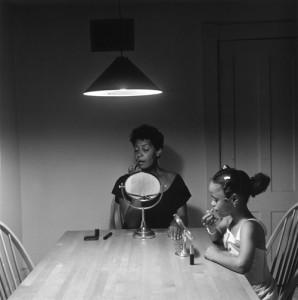The Deconstructive Impulse: Women Artists Reconfigure the Signs of Power, 1973-1991 is the featured exhibit at CAMH (Contemporary Arts Museum Houston) running through April 15. The art on display is a multi-media extravaganza of work done by various female artists from the 1970s until 1991. The show deals with the idea of the construct, both gendered and racial. The questions that beg to be asked within these contexts are about female identity and whether it is more a product shaped by media outlets like television, movies, newspapers and advertising. The foundation of this idea comes from the nature vs. nurture debate. In this show, we know the artists’ answer to this question.
Cindy Sherman’s work uses the media of photography and covers various female guises or stereotypes that we are exposed to in the Western world. For example, “the lonely housewife,” “the sexy, husband-stealing secretary,” “the over-sexed vixen,” or the “faux innocent and titillating cheerleader.” These tropes are so common and unquestioned in our society that we instantly recognize them and know what they represent without even questioning their authenticity.
An interesting facet of Sherman’s work is that she acts out all of these constructs and is the only female ever displayed in her work. By trying to simultaneously “be” all of these different women she highlights the ridiculousness of these cookie-cutter types. The wigs and over-exaggerated expressions she uses underscore this point. Her work suggests to the viewer that women are socialized to play these roles and even perform them on a daily basis. It brings a whole new meaning to the idea of masquerade. Of course, men choose identities as well but they are normally the agents whereas women are generally the spectacle. We glean a deeper understand of social constructs and how women traditionally are the malleable, transparent vessels or “muses” for another person’s vision.
Another artist who contemplates the idea of how social constructs are made through mainstream media is Jenny Holzer. Holzer uses the ticker tape, a common advertising tool that generally barrages our collective minds with mundane advertising messages. Holzer reinvents this as a tool for sharing more poignant messages. As the red digital messages flash by on the ticker tape, it forces the viewer to stop and carefully decipher the written statements. They are not done in short, staccato, easily digestible, advertiser-friendly bites but are generally long sentences that need to be read in their entirety to understand the meaning. People can “read” different reasons into her purpose for this. For this reader, the purpose is to bring our awareness to how advertising seeps into our collective psyche and that these short, sparky, seemingly innocuous messages may be forming our subconscious thoughts a lot more than we think. What sort of messages are we consuming about race, gender, identity?
Overall, this exhibition is a thinking person’s show. It isn’t for those wishing for a visually pleasing experience. Some of it is unsettling, a lot of it provocative, and all of it done by women. Some of these women are gaining more credibility as serious artists in their own right rather than “women artists,” and that is something to celebrate.
* This show runs from January 21 – April 15, 2012

